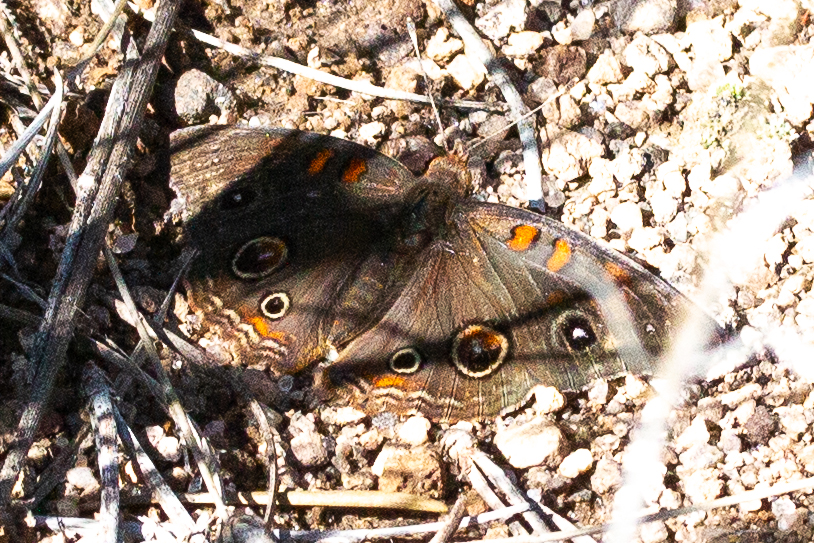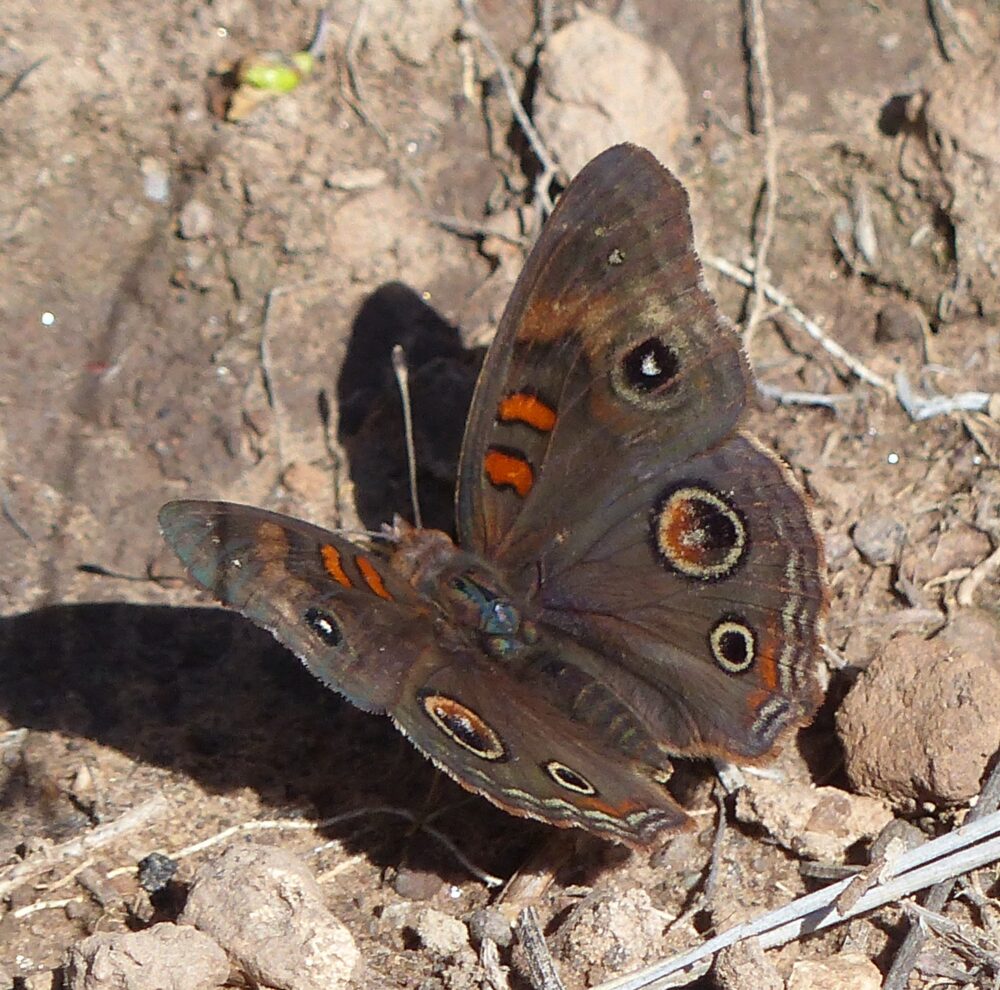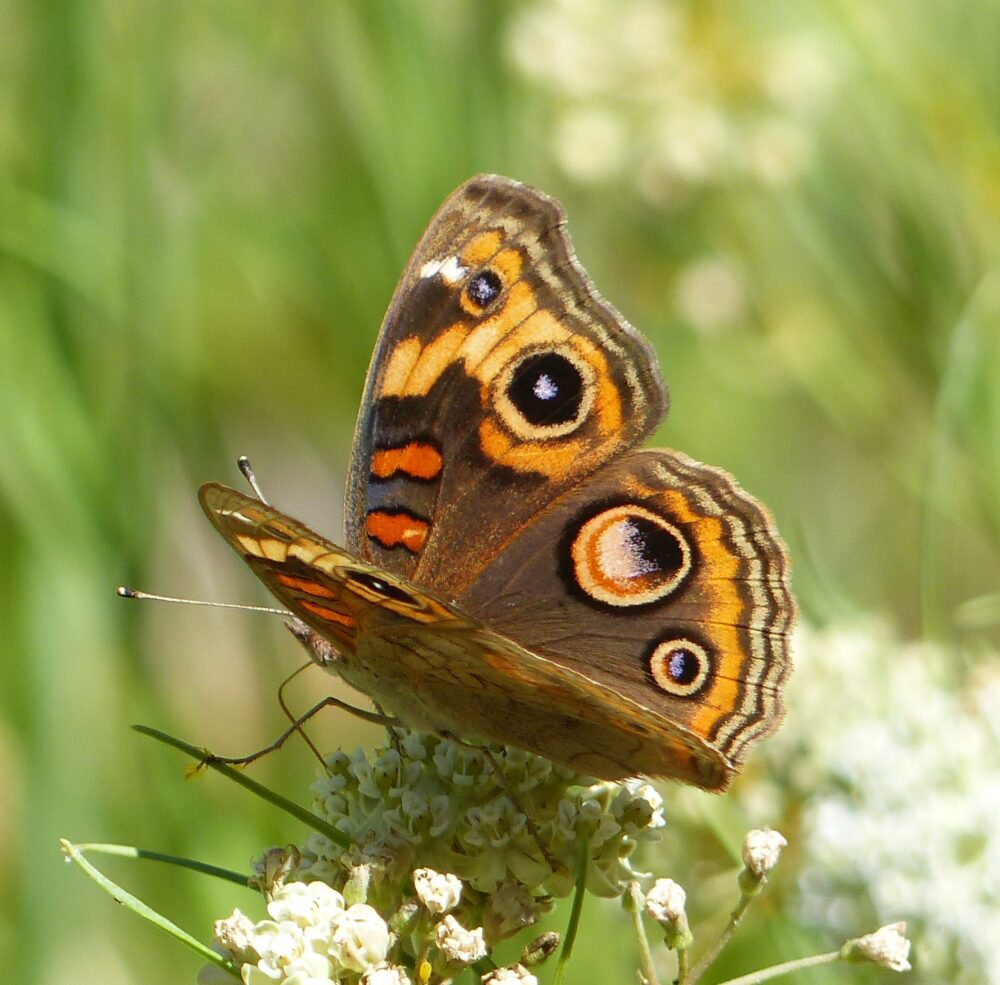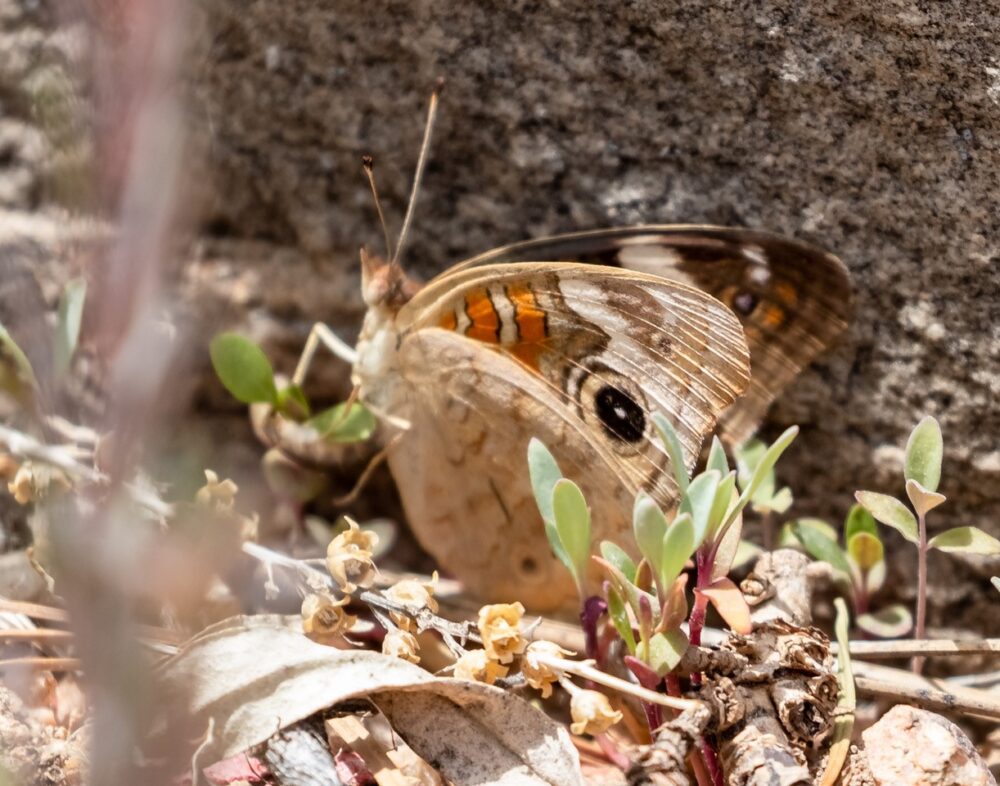Dear New Mexico Butterfly Admirers,
Last year’s Los Alamos Butterfly Count produced a big surprise: a ‘Dark’ Tropical Buckeye, which was new for Los Alamos County and the farthest north it had ever been seen in New Mexico (see photo below). Little did we know then what it foretold. This year, Rozelle Wright and others have been spotting Buckeyes in various forms including another Tropical Buckeye, in early May no less. Rozelle wanted to understand what she was seeing and she would not let me skate with a superficial reply.


Buckeyes are of modest size but they display beautiful eye-shaped markings, called ocelli. Behaviorally, Buckeyes patiently patrol watercourses, wet or dry, flying up one stream bank for a while, then turning around and returning — up one side, down the other, no more than a few feet above ground level, hoping to encounter a potential mate. Buckeyes stop frequently to bask in the sun or take nectar from floodplain flowers. With wings spread, they make tantalizing photographic targets.
Traditionally, New Mexico and the greater Southwest have been home to what was called Common Buckeye (Junonia coenia), the same species that prevails in the eastern United States, easily identified by the prominent white band angling across the upperside of each forewing and enclosing a eyespot (see photo below). However, recent DNA studies1,2 first revealed and then confirmed the western, white-banded buckeye as a cryptic species, a visual dead ringer for eastern J. coenia, but now understood to be the genetically distinct western sister species known as Gray Buckeye (Junonia grisea).


Gray Buckeye, as we now must call it, has long been a routine component of butterflying in southern New Mexico, a regular presence along creeks and arroyos from Hobbs and Portales to Lordsburg and Silver City. As with many southern species prone to wandering, Gray Buckeyes would occasionally be spotted farther north, especially during or after the summer monsoons, whose southerly air flow brought moist air, thundershowers, and southern butterfly species. But eventually winter would descend and Gray Buckeyes would be frozen out. They might re-invade the following year, depending on circumstances, but penetrations north of Albuquerque were few and far between.
The second character in this gripping drama (it’s OK, just remember to breathe) also has suffered an identity crisis. It’s now called Dark Buckeye (Junonia nigrosuffusa) and by comparing photos you can see that, while sharing several Gray Buckeye markings, it is missing the distinctive white band on the forewing. On the hindwing, a bright orange stripe near the margin is obvious on Gray Buckeye, but largely absent on Dark Buckeye. For many years the Dark Buckeye masqueraded as the ‘Dark’ subspecies of the Tropical Buckeye (Junonia genoveva nigrosuffusa), but recent DNA studies1,2 showed that it is not a subspecies of Tropical Buckeye, but its own full species.
Butterfly watchers had never seen a Dark Buckeye in northern New Mexico because it comported itself like a truly subtropical critter. Indeed, Dark Buckeyes were scarce even in southern New Mexico. For decades, my few sightings of Dark Buckeye occurred only during trips to New Mexico’s Bootheel or to southern Arizona.


All those geographical constraints on Gray and Dark buckeyes, which I took for granted right along with a stable climate, have now been blown out of the water. Gray Buckeyes have materialized farther north with each passing year, or so it seems. Then in 2019, Dark Buckeyes were seen in several Northern New Mexico counties for the first time ever. Already this year (it’s barely June), northern observers are reporting Gray Buckeyes and Dark Buckeyes. These butterflies are not transcontinental, round-trip migrants like Monarchs or Painted Ladies, but by patiently following New Mexico’s best north-south river corridor, the Rio Grande, over successive generations, they are able to work their way pretty far north at least until winter cold. Shockingly, however, our recent winter failed to freeze out Buckeyes of any kind and now we must expect further expansion of Buckeyes through the 2020 warm season. I’ve already seen it above 9,000 ft elevation in the Sangre de Cristo Mountains above Santa Fe.
In addition to the two named forms, Gray and Dark, we are seeing a range of intermediate forms (see two examples below). Butterfly observers on the Colorado Front Range are seeing the very same mix of Dark, Gray, and intermediates. This suggests that breeding boundaries between the two species are not very effective. Given that they have very similar behaviors in the landscape, they no doubt encounter each other frequently, inter-specific matings do occur, and offspring may have reasonably high viability and fertility. It seems that DNA analyses in the laboratory may be able to tease out distinct species, but in the realities of living nature, these two species seem incompletely separated at best. Gray Buckeyes are occasionally hybridizing with Dark Buckeyes.




Many subtropical butterflies that find their way to northern latitudes are lost, confused, vagrant individuals that have no chance of finding a mate or reproducing. Pipevine Swallowtails (Battus philenor), for example, are occasionally seen in Northern New Mexico, but there are no pipevines (Aristolochiaceae) growing here and thus no satisfactory places for females to put eggs. Subtropical vagrants are fun to see, glimpses of butterfly diversity in more exotic climes, but they and their DNA are goners.
Buckeyes, in contrast, are finding mates and places to put eggs in Northern New Mexico. Buckeyes oviposit on plants in the Plantain Family (Plantaginaceae), for which there are a few native species and some introduced, non-native species that may naturalize. Los Alamos’s Marc Bailey recently watched a Gray Buckeye ovipositing on new shoots of what is thought to be Purple Toadflax (Linaria purpurea), a Mediterranean forb sold in some nurseries. A butterfly’s act of placing an egg is usually furtive, near the ground, quick, and hard to photograph, but see Marc’s photo below and note abdomen curled to place egg on the plant.


So it seems that Buckeyes, both species and everything in between, are on a journey of expansion in the Southwest. Wherever you are in New Mexico, you are in good position to watch and document it as it unfolds over the coming months and perhaps years. This year’s spring Buckeyes are mating and placing eggs. Those eggs should produce a new generation of adults in summer, and there could easily be yet another generation in flight come autumn. Keep your eyes peeled, as they used to say, your lens caps off, and let’s see how things eventuate!
Steve Cary, Santa Fe
1. Melanie M.L. Lalonde and Jeffrey M. Marcus. 2018. Getting western: biogeographical analysis of morphological variation, mitochondrial haplotypes and nuclear markers reveals cryptic species and hybrid zones in the Junonia butterflies of the American southwest and Mexico.
2. Qian Cong, Jing Zhang, Jinhui Shen, Ziaolong Cao, Christian Brevignon and Nick V. Grishin. 2020. Speciation in North American Junonia from a genomic perspective.

Thanks for this article Steve, what wonderful research you and others are doing! Joe Schelling just shared this article with me, as he was photographing what looks like all 3, Grey, Intermediate, and Dark in one field at the ABQ Open Space Visitor Center last Saturday, June 14th. I’m working with volunteers there to build and care for soil there in the creation of a Common Edge Habitat Field, planting blocks of native perennial flowers for a wide range of pollinator species, along with public participation and learning.
Peter, thanks for your kind remarks. Joe told me about your restoration project and kudos to you for undertaking such a beneficial effort for people and ecology. I suspect your project area will be a magnet for butterflies and other pollinators for a long time to come. I can’t wait to hear what Joe and others see there!
Steve
Steve,
Thank you for doing this research. I had not known about the dark Buckeyes until last year when I spotted one on the Rio Chama just below el Vado dam. It was August. I looked them up in my Scott book. I am seeing at least two varieties on my place here just north of Espanola and it is their best year numbers-wise. We have a lot of plantain.
Great post Steve! The buckeyes overwintered in SE Colorado as well, and the range of phenotypes from dark to pale and everything in between is truly mind boggling! Up here we are also getting typical coenia in the grisea-nigrosuffusa mix along with intermediates. The recent paper by the Grishin lab described Junonia stemosa as a new species (!) from Texas, and many of our “nigrosuffusa” phenotypes and intermediates could be stemosa, if it is actually a real taxon (it is supposedly best characterized by its genomic makeup and hard or impossible to identify with morphology). To me, the taxonomic arrangement of four species proposed in the recent Grishin lab paper make no sense when one studies the current buckeye situation in NM-CO, unless their results are reinterpreted so that coenia, grisea, nigrosuffusa, and stemosa (which is basically the ‘eastern nigrosuffusa’) are all subspecies of one single species. That seems to be the only way to explain what we’re seeing, and geographically, TX-NM-CO is where all of these taxa meet… So perhaps a better title for this post is ‘A Tale of Four Buckeyes’? 😉
Andy, thanks for adding to the dialog. I wondered if coenia might be in the mix, but I don’t have any feel for stemosa. I can be comfortable with the notion that there can simultaneously co-exist multiple DNA-trackable taxa, a fair bit of successful interbreeding/hybridization, and a rainbow of phenotypes. Let’s call it a “complex” of incompletely speciated forms. Makes my life a lot easier. and hey, don’t call me “Four-Eyes!” :^)